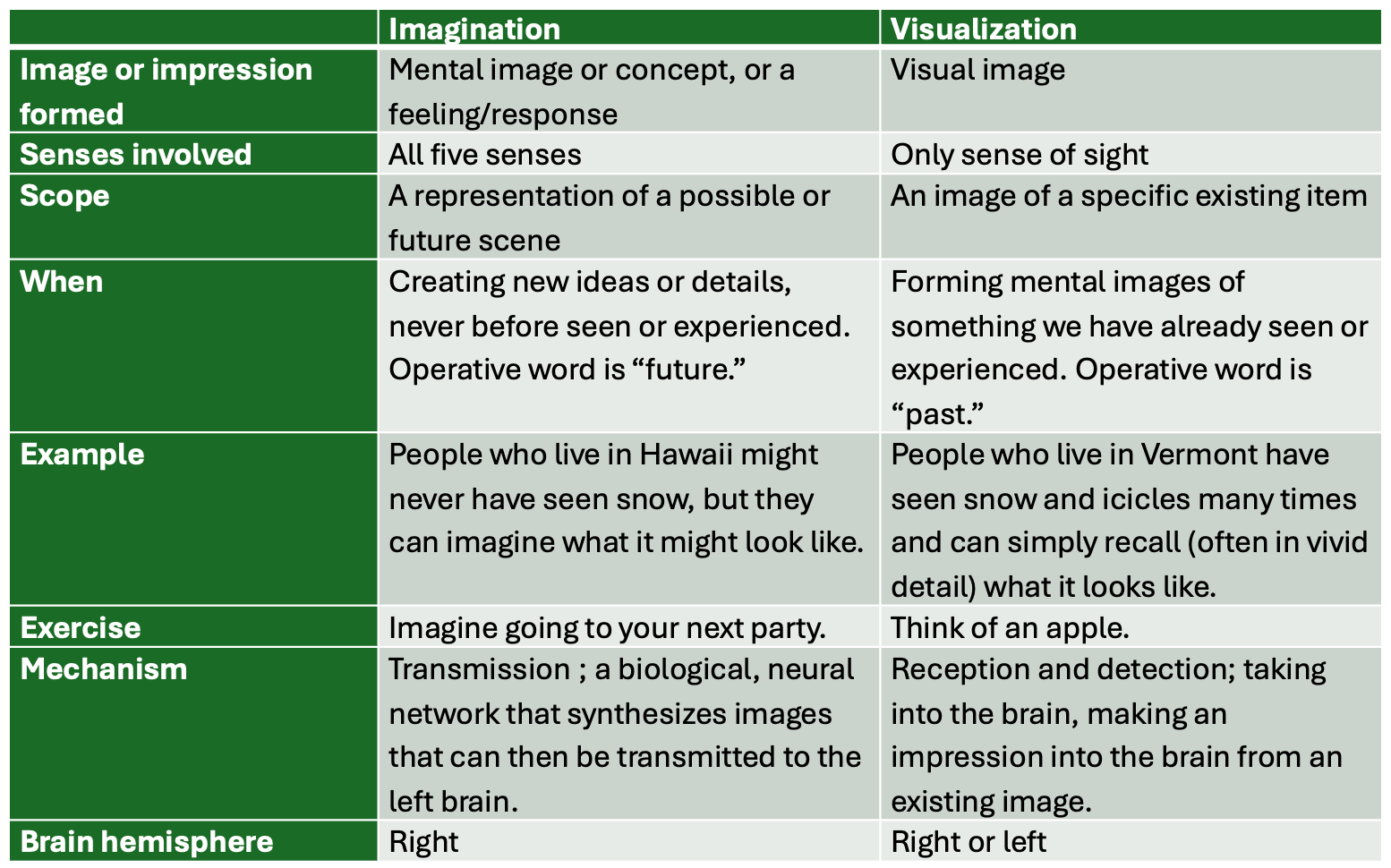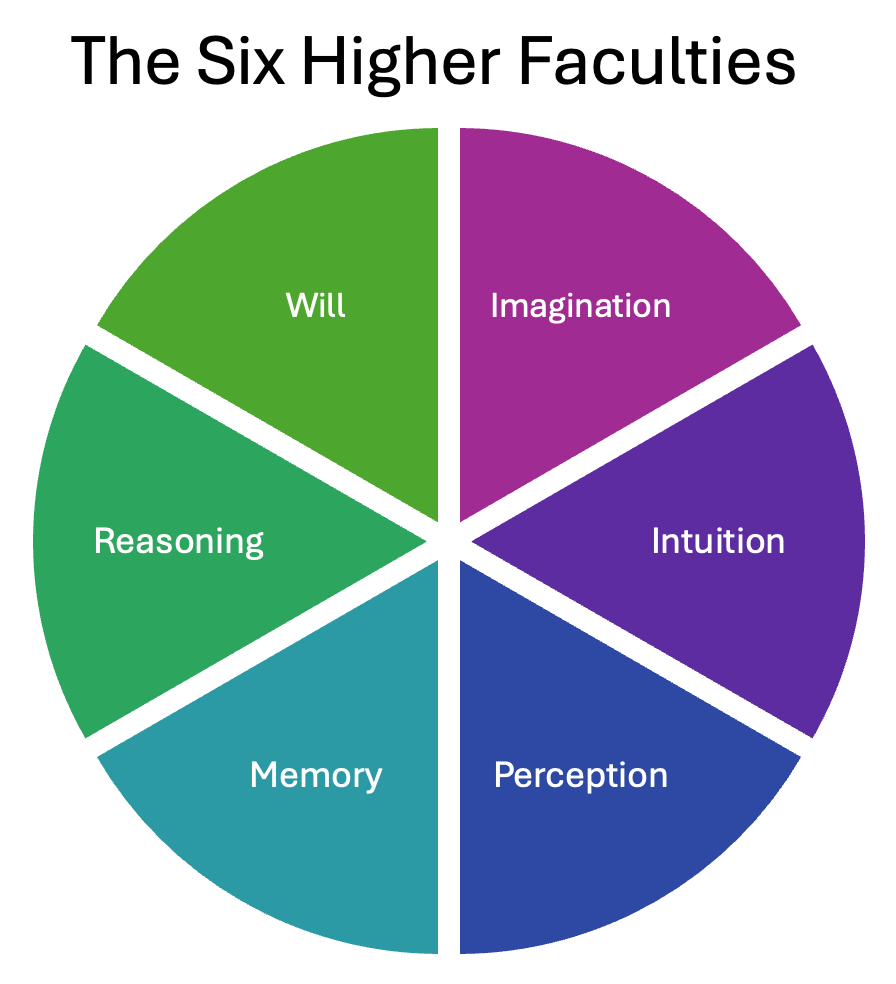Imagination is vital for a good business. Worried you don’t have enough? Read on!

This post was first published on my Medium blog—follow me there for the most up-to-date entries!
I remember it distinctly. A decade or more ago, a woman told me I didn’t have any imagination. It felt like an insult. Worse still, it bugged me that she might be right. I began to wonder: Do I really lack imagination? And if so, how can I improve my imagination?
Ask yourself this: Have I recognized the power of imagination as one of the six higher human-only faculties? Are there personal or professional consequences of not using imagination? If I improve my imagination, will it help me to grow my business or just become a better person?
Imagination vs. visualization
Milton and colleagues state that the term “imagination” is “ambiguous” and often confused with “visualization.” So if I want to figure out how to improve my imagination in business, I’d better be thinking of the right thing! What are the differences?
Milton and colleagues use the term visualization as “the ability to summon up an image of a specific item (‘imagine an apple’),” and imagination as “the richer ability to represent some possible or future scene (‘imagine the next party you go to’).”
Combining information from Milton and colleagues, Silva, Hasa, and others, I compared basic features of visualization and imagination. Although they are different, visualization and imagination are both important for our creativity, and both are related.
As John Bradley explains, “Visualization acts as a conduit for imagination, enabling us to bring our imaginative ideas to life through vivid visualizations. By visualizing our thoughts and ideas, we make them more tangible, concrete, and accessible.”
I think of it this way: Imagination is like having our right brain “see” images or ideas that are floating around in the air we breathe; they are transmitted to our left brain and made into something more tangible, concrete, or accessible. Visualization can be done by the left brain alone, but imagination requires the creativity of the right brain.

It seems that, of the two options, imagination is the more powerful. I can see how conjuring up things I haven’t yet experienced can help me more than looking back on things I already have. So that led me to investigate further what, exactly, imagination is.
Logic will get you from A to B. Imagination will get you everywhere.
— Albert Einstein
What is imagination?
When we think of imagination, we might think of creations from painters, music composers, and especially inventors for their imaginative fantasy, such as Henry Ford. Indeed, those represent one type of imagination, However, I learned there are 8 different types of imagination. In a previous post, I explained and gave business-related examples of Professor Murray Hunter’s psychological model with 8 types of imagination. If you want to improve your imagination, consider all 8 kinds:
- Effectuative imagination
- Intellectual or constructive imagination
- Imaginative fantasy
- Empathy
- Strategic imagination
- Emotional imagination
- Memory reconstruction
- Dreams
Might we sometimes feel more capable of having some types of imagination than others? Of course. Some days, I feel like I can’t imagine anything. In his fascinating book The War of Art, Steven Pressfield says the Muse just hasn’t come. On those days, I hope that such dryness will soon disappear and I will defeat Resistance (Pressfield personifies this concept) and become more imaginative. I feel okay with that.
However, there are other questions that feel unsettling to me. Are there some people who truly have no imagination? Are there people who have a seemingly never-ending imagination? Very possibly.
No imagination, abundant imagination
Is it possible that some people truly have no imagination, whereas others have more than enough? Yes. In 2015, Zeman even coined terms for these experiences: aphantasia and hyperphantasia.
- The term phantasia refers to imagination, appearance, and visualization.
- The prefix a means without. Hence, those who seem to have no imagination would be described as experiencing aphantasia.
- The prefix hyper means excessive. Hence, those with hyperphantasia have seemingly limitless imaginations.
To my astonishment, several scientific studies, including Milton’s, found that some people claim to have no imagination (aphantasia) whereas others seem to have a greater-than-normal ability to imagine things (hyperphantasia).
Aphantasia
Zeman’s study showed that yes, there are people who simply cannot imagine. But here’s the good news: Zeman tells us that only 1–3 percent of the study group could be classified as aphantasic. If you think you have no imagination (maybe because of a snarky comment by someone a decade ago, for example), just remember there’s a low likelihood that you’re in that small percentage of people.
Aphantasia can be either congenital (existing from birth or shortly thereafter) or acquired. The acquired type is associated with an accident or some other kind of trauma.
If you’re wondering if you might have aphantasia, there are some informal tests you can perform on yourself. For example, as you recall a favorite relative, can you see, in your mind’s eye, their:
- facial features, hair shape,
- characteristic movements and gestures,
- typical clothing?
Most people can easily conjure up those images. If you cannot recall such details, you might be in that small percentage of people who simply cannot imagine things. Find out more about what it’s like to have aphantasia. Also, like autism, aphantasia is not just yes/no; it’s a spectrum. There might even be ways you can exercise your mind and improve your imagination despite it.
Hyperphantasia
Hyperphantasia is the opposite of aphantasia. It’s about “highly developed imagery skills.” According to Zeman, about 10% of the people in the study group exhibited signs of hyperphantasia.
You’ve probably met people with hyperphantasia. They can seemingly make something out of nothing. They can see a dilapidated old house and renovate it into a gorgeous dwelling. They can pick up a bolt of fabric and design a magnificent gown without a pattern. In high school, I knew there was something extraordinary about my friend Nick Gasdik, who could write music in his head. Decades later, when he came to my father’s funeral, I learned he was an Emmy-award winning film producer and composer. Wow. These people might be closer to us than we realize.
Are you one of these people? If you can see things in your mind’s eye, as sharp and clear as if you were sitting in a movie theatre, you may have hyperphantasia. Learn more about hyperphantasia, including questions that span all five senses.
The Imagination is the most powerful most miraculous inconceivably powerful force that the world’s ever known.
— Napolean Hill
Using imagination and visualization
Napolean Hill tells us that, unlike other animals, humans are equipped with six higher faculties. One of these faculties is imagination. It’s very likely you can imagine something better in your life. You might never end up experiencing hyperphantasia, but with an awareness of your imagination, you can create better processes and outcomes for yourself and the world.
Your imagination is powerful. What can you do to improve your imagination?

Infographic by author
Use visualization to jump-start better imagination
Remember that visualization creates left-brain images that might be transmitted to your right-brain imagination. That means you can transform visualization into imagination. So how can you jump-start that process?
Anthony Metivier, PhD, insists that “visualizing” is more than just about seeing pictures in your mind. Here, Metivier gives five powerful exercises and techniques that include the:
- candle exercises (including several variants, which are fascinating!)
- apple visualization exercise (and variants)
- number skipping exercise
- globe exercises
- clock
You can use exercises like these to push your visualization further and improve your imagination!
Daydreaming to improve your imagination
If you have dreamed while asleep or daydreamed while awake, you have used your imagination. In psychology, positive daydreaming is called “indulging.”
Daydreaming has often been considered a waste of time, or even detrimental. However, mental health expert Barbara Field describes five benefits of daydreaming. If you feel stuck in your business or personal life, try daydreaming to improve your imagination.
I have a friend who says she sets aside one afternoon a week to simply daydream about living a better life and growing her business. She has been very successful in making both happen.
Guard against what psychologists call “dwelling” or “catastrophizing.” In simple terms, that’s called worrying. We can use our imagination to conjure up visions of a future that is better, or worse. Be alert. If you catch yourself worrying about some catastrophe which may or may not ever occur, try to redirect yourself, especially if you’re involved in decision-making.
Imagination in my business
So once again, I ask myself, do I truly have no imagination? Or, if I do have imagination, which types of imagination come most easily or perhaps most frequently to me? And how can I prove to myself that I’ve used my imagination to grow myself or grow my business? Here are a few examples:
- Intellectual or constructive imagination: I’m strong at this one. If I have a framework or some parameters, I can create something that I’ve never seen before. If I know the size of a preterm baby’s head, and what a regular-stitch knitted hat looks like, I can design and make a tiny brioche-stitch hat to fit a premature baby. Or I can read an academic article and draft 10 short LinkedIn posts that don’t look anything like the original publication.
- Empathic imagination: One aspect of empathetic imagination is to cognitively imagine what life is like for someone very different from oneself and figure out how to proceed. I mustered what little empathic imagination I do have when I needed to de-clutter a hoarder’s house a few months ago. Empathy can also be about re-framing to help someone else see a more favorable situation.
- Strategic imagination: I use my strategic imagination by embracing some seemingly negative event and imagining how to capitalize on it. For example, as I saw other business owners struggling shortly after Covid erupted, I became certified as a business coach, as an online training professional, and a Full Focus Pro coach. In short, I saw an opportunity to reinvent myself.
- Emotional imagination: I use my emotional imagination when I help other nurses to see how great their lives could be if they would transform their bedside expertise into non-traditional nursing roles. Yes, they may need new skills, but they aren’t likely to be motivated to acquire such skills without imagining a better future.
- Reconstruction imagination: From time to time, I remember something I’ve done in the past, but I need to fill in the blanks to repeat it. Reconstruction imagination is about imagining a process when most of what you know is the outcome. Similarly, I start with the end in mind when I’m designing a course, and I’m thinking of the steps to be taken along the way.
Could I benefit from improving my imagination? Of course — I think everyone could! But do I have imagination? Absolutely, and I never stop using it! It just might look a little bit different.
Imagination is truly a miraculous, powerful force. We would all do well to use it, recognize its effects, expand it, and be grateful for it every day. If you’re like me, worried that you have “no imagination,” then think of imagination as a muscle to exercise rather than some fixed quality you can’t control. If you want imagination, you’ve got to practice using it!
I am a participant in the Amazon Services LLC Associates Program, an affiliate advertising program designed to provide a means for us to earn fees by linking to Amazon.com and affiliated sites.
This post was first published on my Medium blog—follow me there for the most up-to-date entries!

THX FOR YOUR MUCH SUPPORT!